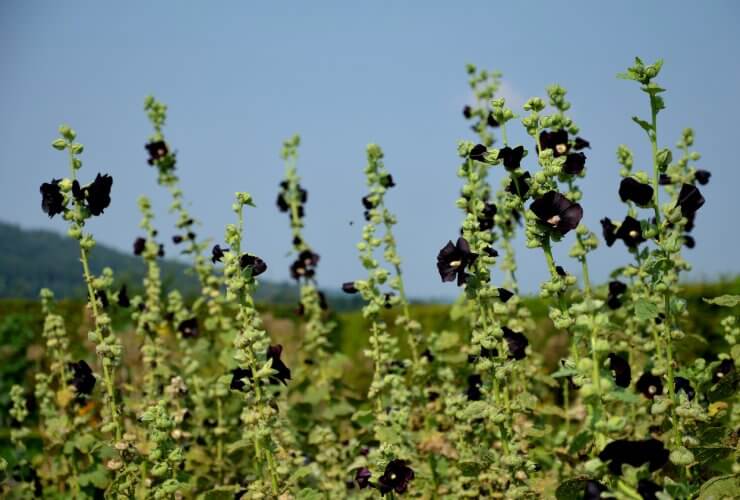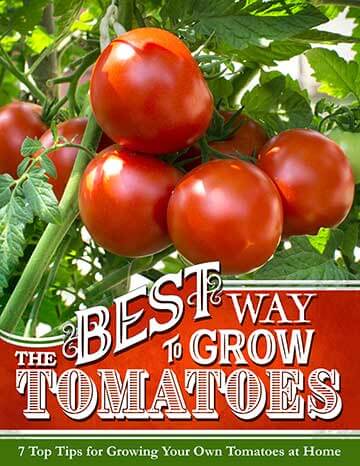
When I first heard about the Black Hollyhock, I’ll admit, I was skeptical. A black flower? In my butterfly garden? Surely, that was a joke. But let me tell you, this dramatic beauty has become an unexpected star of my pollinator paradise, drawing in butterflies like a floral magnet dressed in gothic attire.
Now, you might be wondering, as I initially did, how a black flower attracts butterflies. Aren’t these winged wonders looking for bright colors? Well, hold onto your gardening gloves, because I’m about to let you in on a little secret: Black Hollyhocks aren’t actually black. Cue the gasps!
You see, what we perceive as black is actually a deep, rich purple so intense it appears black to our human eyes. But to butterflies, with their ability to see ultraviolet light, these flowers are a beacon of nectar-rich goodness. It’s like they have built-in blacklight vision for finding the coolest flowers at nature’s disco.
But let’s back up a bit. The Black Hollyhock, officially known as Alcea rosea var. nigra, is a variety of the classic cottage garden staple we all know and love. It’s been charming gardeners since the 19th century, adding a touch of drama to gardens long before black flowers became trendy.
Discover 7 top tips for growing, harvesting, and enjoying tomatoes from your home garden—when you access the FREE guide The Best Way to Grow Tomatoes, right now!
How to Grow Black Hollyhock in Your Butterfly Garden
When I first planted Black Hollyhocks in my garden, I wasn’t sure what to expect. Would they be as robust as their colorful cousins? Would they really attract butterflies? Fast forward to mid-summer, and I found myself staring in awe at towering spikes of velvety, near-black blooms literally humming with activity. Butterflies, bees, even the occasional hummingbird – all were drawn to these gothic beauties like moths to a flame (pun absolutely intended).
Now, let me share a few fun facts about the Black Hollyhock that might just convince you to give them a try:
- Despite their dark appearance, Black Hollyhocks are actually edible! The flowers can be used to naturally color foods or as a dramatic garnish. That said, some people get rashes from Hollyhock leaves and stems, so it’s not something I’m willing to try!
- In the language of flowers, black flowers often symbolize mystery and power. Plant some Black Hollyhocks, and you might just feel like a gardening sorcerer.
- Black Hollyhocks are biennials, meaning they typically bloom in their second year. But don’t worry – they self-seed readily, so once established, you’ll have blooms year after year.
- The deep color of Black Hollyhocks comes from a high concentration of anthocyanins, the same compounds found in blueberries and other dark fruits. These act as powerful antioxidants.
Convinced yet? Great! Now let me share some tips on how to grow these dramatic beauties:
- Sun worshippers: Black Hollyhocks love full sun. Give them at least 6 hours of direct sunlight daily for the best growth and most abundant blooms.
- Well-drained soil is key: While they’re not too picky about soil type, good drainage is crucial. If your soil is heavy clay, consider amending it with some compost or planting in raised beds.
- Space them out: These plants can grow up to 6 feet tall and 2 feet wide. Give them room to spread their wings (or leaves, in this case).
- Water deeply but infrequently: Once established, Black Hollyhocks are relatively drought-tolerant. Water deeply once a week during dry spells.
- Support if needed: In windy areas or if you’re going for a more manicured look, consider staking your Black Hollyhocks to keep them upright.
- Deadhead for more blooms: Remove spent flowers to encourage continued blooming and prevent excessive self-seeding (unless that’s what you’re going for).
- Be patient: Remember, these are typically biennials. Plant seeds in late summer for blooms the following year.
I’ll never forget the first time I saw a Swallowtail butterfly land on one of my Black Hollyhocks. Its yellow and black wings created a stunning contrast against the deep, velvety petals. It was like watching a miniature work of art come to life in my garden.
And it’s not just butterflies. I’ve seen bees bumbling happily from bloom to bloom, their fuzzy bodies dusted with pollen. Even goldfinches have stopped by to snack on the seeds. It’s as if the Black Hollyhock has become the coolest hangout spot in the garden.
But perhaps the most unexpected joy of growing Black Hollyhocks has been the conversations they start. Neighbors stop to ask about the “black flowers,” friends marvel at the unusual color, and fellow gardeners want to know my secret. It’s turned my garden into a community talking point, and isn’t that what gardening is all about? Creating beauty that brings people (and pollinators) together?
So, are you ready to walk on the dark side of gardening? Trust me, once you’ve experienced the allure of Black Hollyhocks, you’ll never look at your butterfly garden the same way again.
And if you want to learn more about planting a butterfly garden, download our free Butterfly Garden Planting Chart. It’s divided into four sections, so you know which plants or flowers you can grow based on the type of soil and amount of sun your garden gets. There are two dozen gorgeously illustrated plants in it, and along with this frame-worthy illustration, you also get these plants in list form where you can discover their botanical name, how much sun and water they need, what kind of soil they prefer, and some additional interesting facts about each of them. Download now!
I’m dying to hear from you all. Have you ever grown Black Hollyhocks? What’s the most unusual flower you’ve planted to attract butterflies? And for those of you intrigued by the idea, what other dark or unusual flowers are you considering for your garden? Share your thoughts in the comments below – let’s create a virtual garden of unique ideas!





All of you are so much kinder to these dark hollyhocks than I was. Sorry, I just couldn’t like them. I did let them grow, however, but said I’d never plant them again. Maybe I’m just the oddball of hollyhock world but this color didn’t appeal to me at all, they were very hardy though and lived through our terrible heat and humidity in Central Louisiana. Guess I like color on my garden palette! Great article as always, Amanda!
I would love to plant some black hollyhocks. Where can I get the seeds or a tuber. I am in Northern Ontario, Canada. And would they grow up here. Zone 2b
Hi. They grow + winter well here in SW Saskatchewan, zone 3a. Check with garden centres for seeds or plants. Our local greenhouse sells the plants each spring.